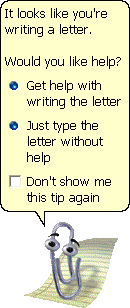I’m old enough that I can remember going into London to see the early launch demos of Microsoft Word for Windows. I was the computer officer for my Cambridge college at the time, and, up to that point, everyone I was helping used Word for DOS, or the (arguably superior) WordPerfect.
These first GUI-enabled versions of Word were rather good, but the features quickly piled on: more and more buttons, toolbars, ribbons, bells and whistles to persuade you, on a regular basis, to splash out on the next version, unwrap its shrink-wrapped carton, and install it by feeding an ever-increasing number of floppy disks into your machine.
 And so for some of us, the trick became learning how to turn off and hide as many of these features as possible, partly to avoid confusing and overwhelming users, and partly just to get on with the actual business of creating content, for which we were supposed to be using the machines in the first place. One feature which became the iconic symbol of unwanted bloatware was ‘Clippy’ (officially the Office Assistant), which was cute for about five minutes and then just annoying. For everybody. We soon found the ‘off’ switch for that one!
And so for some of us, the trick became learning how to turn off and hide as many of these features as possible, partly to avoid confusing and overwhelming users, and partly just to get on with the actual business of creating content, for which we were supposed to be using the machines in the first place. One feature which became the iconic symbol of unwanted bloatware was ‘Clippy’ (officially the Office Assistant), which was cute for about five minutes and then just annoying. For everybody. We soon found the ‘off’ switch for that one!
These days, I very seldom use any Microsoft software (other than their truly excellent free code editor, VSCode, with which I earn my living), so I certainly haven’t sat through any demos of their Office software since… well, not since a previous millennium.
But today, since it no longer involves catching a train into London, I did spend ten minutes viewing their demo of ‘Microsoft 365 Copilot’ — think Clippy endowed with the facilities of ChatGPT — and I recommend you do too, while remembering that, as with Clippy, the reality will almost certainly not live up to the promise!
Still, it’s an impressive demo (though somewhat disturbing in parts) and though, like me, you may dismiss this as something you’d never actually use, it’s important to know that it’s out there, and that it will be used by others.
ChatGPT is famous for producing impressively readable prose which often conceals fundamental factual errors. Now, that prose will be beautifully formatted, accompanied by graphs and photos, and therefore perhaps even more likely to catch people unawares if it contains mistakes.
The text produced by these systems is often, it must be said, much better than many of the things that arrive in my inbox, and that will have some advantages. One challenge I foresee, though, is the increasing difficulty in filtering out scams and spams, which often fail at the first hurdle due to grammatical and spelling errors that no reputable organisation would make. What happens when the scammers have the tools to make their devious schemes grammatically correct and beautiful too?
I would also be interested to know how much of one’s text, business data etc is uploaded to the cloud as part of this process? I know that most people don’t care too much about that — witness the number of GMail users oblivious to the fact that Google can read absolutely everything and use it to advertise to them and their friends — but in some professions (legal, medical, military?), and in some regimes, there may be a need for caution.
But it’s easy to dwell on the negatives, and it’s not hard to find lots of situations where LLMs could be genuinely beneficial for people learning new languages; struggling with dyslexia or other disabilities; or just having to type or dictate on a small device a message that needs to appear more professional at the other end.
In other words, it can — to quote the announcement on Microsoft’s blog page — help everyone to ‘Uplevel skills‘.
Good grief. Perhaps there’s something to be said for letting the machines write the text, after all.